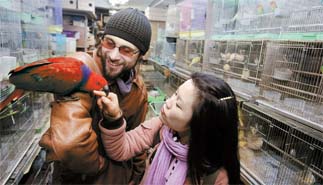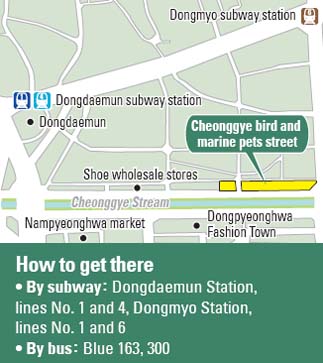Birds of many feathers flock to midcity street

Shoppers on Cheonggye 7-ga eye stacks of cages full of birds and rabbits in front of pet shops lining the street. From roosters to piranha, the Cheonggye “pet street” has them all. By Jeon Min-kyu
What are the odds of hearing a rooster crow in the middle of a modern city like Seoul, where new highrises are erected practically overnight?
Not high, you say?
Then you haven’t been to Cheong-gye 7-ga, where roosters crow their heads off at all hours.
Less than a minute’s walk from the busy market district of Dongdaemun, birdcages and aquarium tanks are piled high amid the bustle of shoppers crowding the narrow streets off the main road along the refurbished Cheonggye Stream.
In front of one of the stores on the street, a young customer was getting her first pet bird.
“You always have to remember to feed the bird,” a store clerk said, handing a small yellow bird to the girl. Fascinated teenage girls were in and out of store, staring at unusual pets they hadn’t seen before.
Here at the Cheonggye bird and marine pets street, people can find pets other than the usual cats and dogs. Inside the profusion of cages and glass tanks are parakeets, roosters, mockingbirds, hamsters, snakes, tokay geckos, piranha and even sturgeon fish famous for caviar.
“I’m not supposed to say it, but scorpions are illegal,” said Yoo Chun-ki, who runs Fish Land. He has two scorpions whose poisonous tails have been wisely snapped off.
Currently there are 20 or so odd pet shops at Cheonggye street across the fashion town of Dongpyeonghwa.
“Pet stores were located mostly on Jongno 5- and 6-ga 40 years ago,” said Park Il-ryong, the owner of Yeongnam Bird Store. “We all moved into this neighborhood because of high rents in Jongno.” Park was one of the first to start a pet bird store in Cheonggye in the 1960s. “Just 20 years ago there were a lot more pet stores on this street,” said Park.
According to Park, the pet industry started with Japanese customers who imported pets that were raised in Korea. “Not only were the pets raised here cheap, Korean pet farms were really good at producing large numbers of birds,” Park said.
The pet market started to grow in the 1980s as the booming economy allowed ordinary Koreans to afford pets.
“Every other household started to raise parakeets and other types of birds; they were not only cheap but also appropriately small for an apartment environment,” Park said. He added that as more parents had only one or two children, birds are emotionally beneficial to children who might otherwise feel lonely.
The most popular birds are the parakeets, especially the large ones. While small birds cost around 5,000 won, larger ones go for around 25,000 won. However, a cockatiel can have a 150,000 won price tag.

A customer holds up a colorful parrot at one of the pet stores along the Cheonggye bird and marine pets street.By Jeon Min-kyu
Yoo of Fish Land said he used to sell common marine pets like goldfish but switched to uncommon pets including geckos and piranha after demand for exotic pets started picking up seven years ago. He has been running the store for two decades.
“The Internet age changed everything,” Yoo said. “People started to ask about different sort of pets that they have seen online.”
Foreigners also frequent the market.
“The foreigners are no strangers to such unusual pets,” said Yoo. “Business has been better recently as the dollar appreciated.”
He said the strength of the Cheonggye pet market is that customers can find any pet that they want as long as it is legal.
“The snakes that are sold here are not poisonous and we only sell those that can be handled,” Yoo said. Snakes command 120,000 to 150,000 won.
As for sturgeon, when they first hatch in May, they trade at 7,000 won. The price goes up to 25,000 won around this time of year.
“The size of the sturgeon determines the size of the tank that they are placed in,” Yoo said.
“I have been raising fish for seven or eight years,” said Kim Yong-soon, 54. Kim is a regular customer of Fish Land, who travels all the way from Incheon.
“It’s not a short distance, but I have no choice because there are no other stores like the ones in Cheonggye,” Kim said.
“Here you can get different types of rare fish that you can’t find anywhere else in the country.”

“Additionally, the interior effect is amazing and having an aquarium in the house helps me to relax and meditate,” Kim said.
“I could go for hours staring into the tank and finding peace.”
But not all of the stores along the streets sell foreign aquatic life.
Geomseong is a standout on the street, selling Korean freshwater fish.
Unlike other stores that are brightly decorated with modern fish tanks, Geomseong sells fish out of a far less flamboyant blue tank.
“Freshwater fish are livelier than tropical fish,” said Park Ju-wha, the owner of Geomseong. “They also live in less heated waters,” Park added.
The owner said unlike what many people think, there are about 200 species of freshwater fish.
Park said most of his customers are teachers and event organizers.
“The teachers buy mass quantities of freshwater fish for class while event organizers purchase them when setting up outdoor ponds. Unlike tropical fish, freshwater fish tolerate cold weather.”
Park, of Yeongnam, said people now are interested in pets because living standards are better.
“When you’re poor, you can’t afford the luxury of raising pets,” Park said. “The popularity of such pets means that people are doing well,” he added.
His last wish is for the government to keep the tradition alive. “There’s a lot of development going on around the city and it would be a loss if the pet street with a history of more than 40 years were to vanish.”
By Lee Ho-jeong Staff Reporter [ojlee82@joongang.co.kr]










with the Korea JoongAng Daily
To write comments, please log in to one of the accounts.
Standards Board Policy (0/250자)